Aaron Ross discusses inbound and outbound sales and how to integrate Sales and Marketing Teams to re-ignite growth. Learn why it is difficult to have accurate and trustworthy outbound dashboards and how to clean up and educate your clients.
Want to see more content like this? Join us at SaaStr Annual 2020.
Aaron Ross | CO-CEO @ Predictablerevenue.com
FULL TRANSCRIPT BELOW
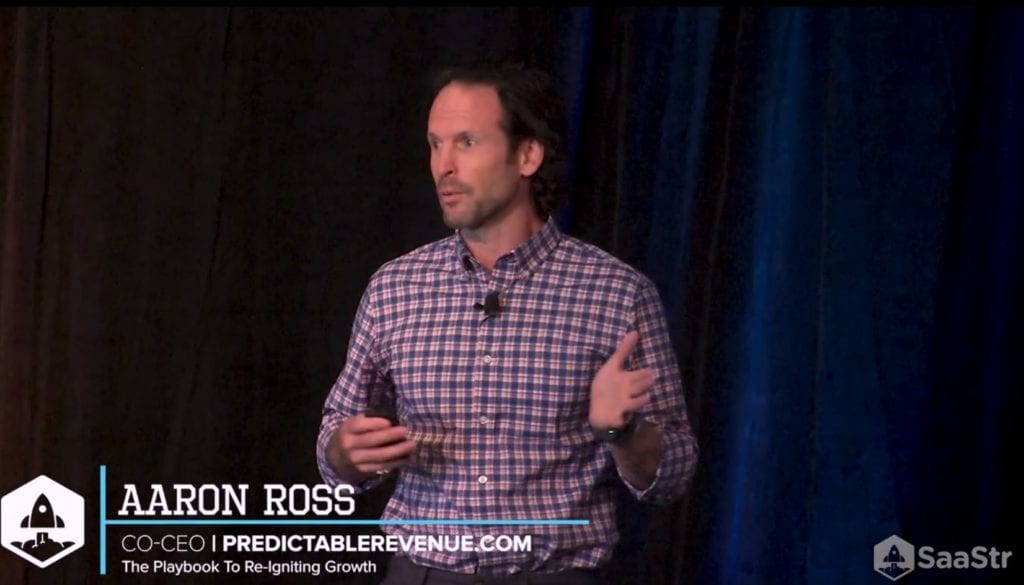 What I was going to talk about today is the playbook for reigniting or even igniting growth. If you aren’t familiar with me, like Rita said, helped create a new outbound process salesforce.com. Good job guys. Thank you. Then, since then … I left Salesforce a long time ago. Really, I’ve worked with lots of companies and really been fascinated with how do you repeat growth? How do you engineer growth? How do you make growth predictable?
What I was going to talk about today is the playbook for reigniting or even igniting growth. If you aren’t familiar with me, like Rita said, helped create a new outbound process salesforce.com. Good job guys. Thank you. Then, since then … I left Salesforce a long time ago. Really, I’ve worked with lots of companies and really been fascinated with how do you repeat growth? How do you engineer growth? How do you make growth predictable?  Then Jason and I did a book called Impossible to Inevitable, which was just updated a couple months ago. Some of you might’ve gotten a copy of this morning. He got 50 copies. So from the newest update of the impossible book, I’m going to share the best practices for igniting and reigniting growth, sort of like the latest lessons learned.
Then Jason and I did a book called Impossible to Inevitable, which was just updated a couple months ago. Some of you might’ve gotten a copy of this morning. He got 50 copies. So from the newest update of the impossible book, I’m going to share the best practices for igniting and reigniting growth, sort of like the latest lessons learned.
Yeah, I mentioned lots of kids, right? Okay. Moving on. Not interesting at all, is it? My fun fact, going to do another book or something about how to … not balance, almost kind of integrate. How do you make more money while being a better parent? I don’t … I guess I’ve done a lot of that. I don’t feel like an expert, but I’m growing a $5 million business while having 10 kids, so that’s been an interesting journey over eight years.
So, From Impossible to Inevitable, second edition. Here’s a couple of the highlights and I’ll share them today, right? How this company called Sagemount, they’re a $2 billion private equity firm, triples evaluations of their investments in three years, how Twilio nailed the billion dollar niche or a niche if you’re from Canada or Europe, and uncommon practices of hypergrowth CMOs.
Okay, before we dive in, by the way, anyone here from Scotland or the UK? Okay. Couple. We’re moving to Edinburgh in October. So yay, because we don’t have enough to do with that many kids. So, one of the biggest trends, and if were downstairs this morning, you would have heard me mention this, is this rise of overwhelm. There’s more of everything. There’s more apps, there’s more content, more channels, more messages, more like, “Oh my God, my head’s going to explode.” So, what does that mean for everyone here? Right? This is going to infect your customers … infect? Affect your customers as well as your salespeople. They both have the same thing around, “Ah, what do I sell? What do I do? I have too many apps.” I’m a salesperson, I’ve got too many apps to use or I have too many types of customers, have too many things. I’m a customer, there’s too many apps. There’s, I don’t know, 10,000 sales apps now or 10,000 marketing apps.
So that’s, I think, the Uber-trend and that affects everything here. So really a lot of what comes down to growing is focus. So, here are some reasons why growth stalls or it doesn’t start in the first place. So, for example, you’re trying to skip a step and I’ll explain that. I get this from David Skok. I loved it actually when he said it, it made so much sense. Companies don’t have enough sales roles. Now, how many people here have read Predictable Revenue? Yeah. Okay. Pretty much everybody. It’s funny, there’s lots of cities you ask that and there’s like a couple of hands go up. I’m like, “Come on.” But okay, if there’s not enough sales roles, it’s … people still have muddy lead generation metrics. We have this theoretical messaging. We haven’t nailed our niche in terms of the messaging and the targeting that we really need to do to figure out who our ideal customer is.
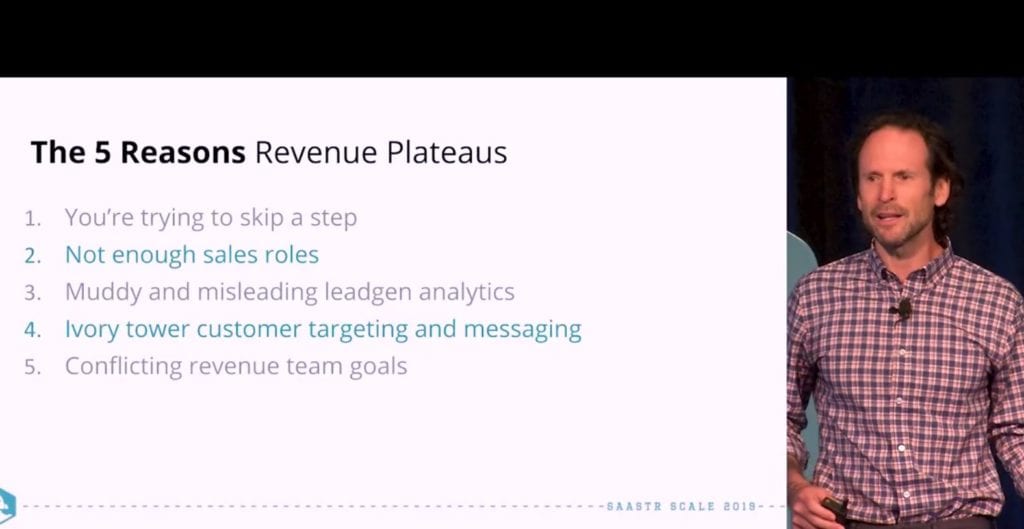 The last one is, a lot of times, sales and marketing. If you’re big enough to have sales and marketing, because I know some of you aren’t, they don’t always work together. Anyway, skipping a step. Skipping a step, pretty simple. So from David Skok, he has these big three things. It’s a new presentation he’s developing. First, you get product market fit, then you create predictable revenue, and then you scale. Now the problem is people keep trying to skip the second step. We’ve got some customers who are buying, let’s go. We’ve done that at predictablerevenue.com even. So it’s people, I think a lot … it’s impatience to grow.
The last one is, a lot of times, sales and marketing. If you’re big enough to have sales and marketing, because I know some of you aren’t, they don’t always work together. Anyway, skipping a step. Skipping a step, pretty simple. So from David Skok, he has these big three things. It’s a new presentation he’s developing. First, you get product market fit, then you create predictable revenue, and then you scale. Now the problem is people keep trying to skip the second step. We’ve got some customers who are buying, let’s go. We’ve done that at predictablerevenue.com even. So it’s people, I think a lot … it’s impatience to grow.
So, again what David says, trying to force progress by jumping ahead before completing the current phase is kind of like two steps forward, three steps backward, because we’re in such a rush, because we see all of these stories around people launching and growing. So one of the ideas from Jason that I loved, that we put into the from Impossible book is this idea of a year of hell and some timeframes. Now, often for a SaaS company, it takes two years before you know whether it’s going to work or not or what you got. It could take longer and it might be five or 10 years to exit. Right? So I think our timeframes are so distorted by social media in terms of what to expect and how long it should take. Remember, what gets published is kind of what’s exciting, which is typically things happening quickly or failing and the really … the stuff that people do every day, which is all the long, boring grind doesn’t get a lot of air time, but that’s really what it’s about. Is anyone not going through a long, boring grind? There might be one or two.
Okay. That’s natural. When you post in your social media, what do you post about? You’re looking about your day. A lot of it can be kind of boring or busy, but you post the highlights, typically, because who cares about you brushing your teeth, really? You’re not going to post about if you’re yelling at your kids, because first of all, it’s totally inappropriate to be yelling at your teenager, because I never do that, and start videoing it and then to post it. You’re not going to do that. So, there’s these reasons why we’re surrounded by an artificial distortion of our reality, which, again, I think feeds our impatience. It means we try to skip a step. Okay, so now I’m going to get to more of the tactical things around sales and marketing that will help drive growth, because again, first, I think it’s our impatience and expectations. We shoot ourselves in the foot.
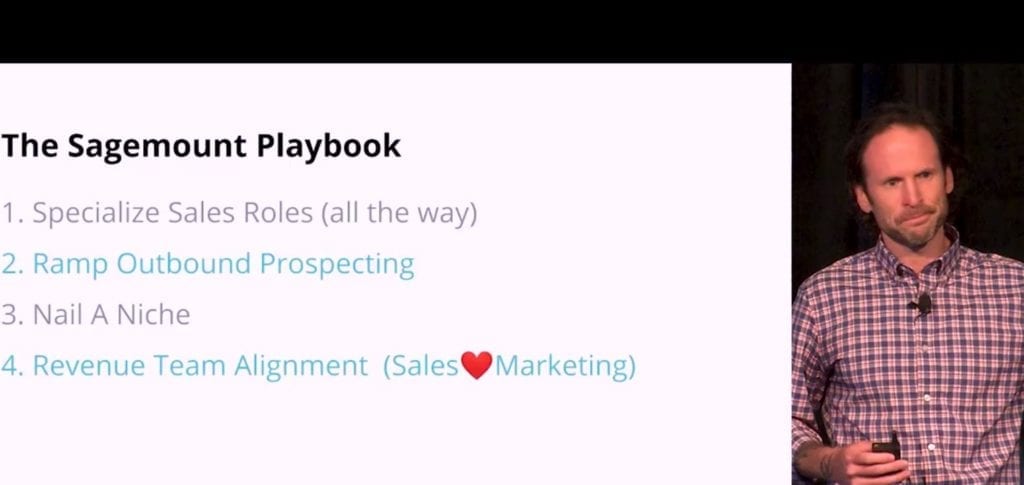 So, Sagemount, and actually, I just caught this beforehand. Sagemount’s a multi billion dollar private equity fund that we do a lot with and they were really kind enough to add a lot of details for one of the new case studies in the book. How did the tripe their investments in three years in terms of valuation? Okay, so again, this repeatable growth. So, one of the interesting facts is, they did this analysis and they said, “Okay, when we make an investment, we can … without looking at M&A or process changes or pricing or sales growth, what they identified was 70% of the increase in valuation of their companies came from increasing organic sales growth. So not from merging companies together, which is part of it, or improvements, it was really that organic sales growth. More leads, more sales.
So, Sagemount, and actually, I just caught this beforehand. Sagemount’s a multi billion dollar private equity fund that we do a lot with and they were really kind enough to add a lot of details for one of the new case studies in the book. How did the tripe their investments in three years in terms of valuation? Okay, so again, this repeatable growth. So, one of the interesting facts is, they did this analysis and they said, “Okay, when we make an investment, we can … without looking at M&A or process changes or pricing or sales growth, what they identified was 70% of the increase in valuation of their companies came from increasing organic sales growth. So not from merging companies together, which is part of it, or improvements, it was really that organic sales growth. More leads, more sales.
So, kind of the four highlights, and there’s a few other … These are the four big things they do. The four big things is really they specialize their sales roles, I would say all the way. We’ll get to that. Ramp lead gen, they focus on outbound, but everyone … I don’t know, might be inbound at some point for you, but ramp lead gen. Nail a niche is part of that, which is really get smart and targeted around their type of customer and messaging and have sales and marketing really work together in alignment. For them, their rule of thumb is, if they can get a companies revenue up by a million dollars in ARR, they should expect a $12 million dollar valuation increase, right? So that every revenue increase is a big deal.
So here’s an example. There was a $40 billion dollar investment in a services company. I think it was somewhere in the Midwest, IT services, and they were growing, made 10% a year. Again, pretty classic. They had half a dozen sales people doing everything and most of the leads were from word of mouth or from channel partners. They come in whenever they came in. Right? They wanted to triple that growth rate and valuation, so what they were hyper-focused on are really three main metrics. Again, I think it’s so easy with all the technology now to get overwhelmed with too many metrics. You get dashboard clutter. If you … hopefully you have dashboards. Some people don’t, but then its’ too easy to put too much stuff on there, so it’s just … it’s really simple. More meetings, more qualified meetings, more proposals, more deals. Now, yours may be different, but pretty simple.
At the end of … I was about to say end of the day, but that gets over-said. Okay, so one of the things around specializing sales, and this should not be new, but where people get this wrong, okay, this is about focus. You’re going back to the uber-trend. When sales people are doing too many things, they struggle, if they’re targeting too many customers, too many apps, too many responsibilities to learn. So this is why specialization works so well, people doing fewer things better. So, I think where we need to take it further is creating more roles. If you have one SDR, whatever you call them, BDR, SDR, duh duh duh, junior sales person doing both, inbound lead response and outbound prospecting, great. As soon as you get two, that needs to change. If you have two SDRs, sales development reps, you need … outbound will not work without dedicated people to it. It just won’t. That’s one example. Yes, I know there’s so many gray areas.
The other one is, as soon as you can, again, split the new customers signing versus account management/customer success. So I think, again, people wait to long or they don’t create enough roles. You really want, usually, more roles in your sales team is kind of the default. I don’t think I’ve ever seen a company that had too many sales roles. I see them all the time that don’t have enough. If you have all these, then add some interns, add some junior people in your operations or sales operations. It’s a great place to bring people up when they’re moldable and not as expensive and they’re getting sort of … they can work in a job and they’re getting paid. They’re getting paid to be trained to be ready for the next job.
In lead generation, it’s really hard to get accurate metrics that you can trust. It’s easy to get metrics. Okay, let’s stick to outbound for a second. Especially in outbound, I never see dashboards that are completely accurate and trustworthy. When you dig below the metrics, there’s always fudge factors. With outbound, there’s a lot of subjectivity. One of the great unknown challenges or unrecognized challenges is that it’s really hard to create a trustworthy outbound dashboard because of the subjectivity. Was this qualified or not? I don’t know. If the salespeople receiving outbound appointments are trained, they’re just like, “Okay, I’ll do my CR a favor. I’ll upgrade it.” They don’t really know. Was it outbound or inbound? There’s all these gray areas around attribution. We get inbound leads. Was it triggered by an outbound prospect or sending emails? Or making it something on social and it came through the website. There’s all these gray areas, right? This is probably the number one thing we work to clean up with clients, is just clarity around metrics and lead generation, especially outbound. If you don’t have clear lead gen metrics, then you don’t know where your leads are really coming from, so you don’t know really where to invest or double down. It’s just …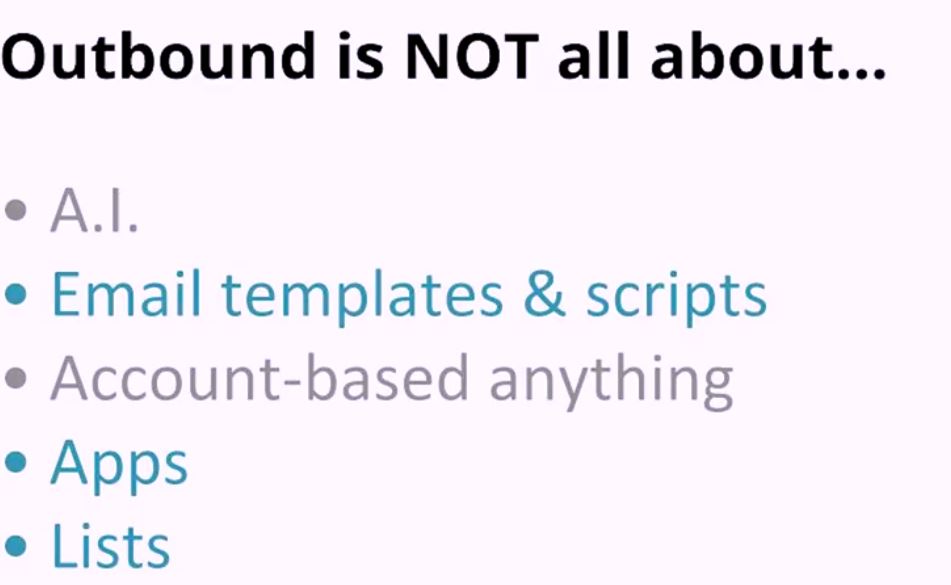
So, just a thing on outbound, right? Outbound is so many great apps. It’s not about the apps, the list, AI, email templates, or anything else. Outbound is really about the dashboard. If you have an outbound program, whether it’s in-house, remote, outsourced, whatever it is, I just … 98% of you will have inaccurate metrics. I can almost guarantee it. Okay, maybe 96%. Really, because I see this all day long. If you don’t know … how many times do people say, “Oh, we’re getting $500,000 a pipeline a month from out outbound program.” Okay, well, when you really look at it, it might be half that, whether it’s because it’s kind of inbound leads, it got poached by outbound, whether on purpose or confusion or a bunch of fluff that’s being upgraded that’s not real. Happens all the time.
So, this is our dashboard at home. This is, again, big kids. This is our family car. I like to see we have a Hummer H2, but that’s our small family car. By the way, both are for sale because we cannot take them to Scotland, if you’re interested.
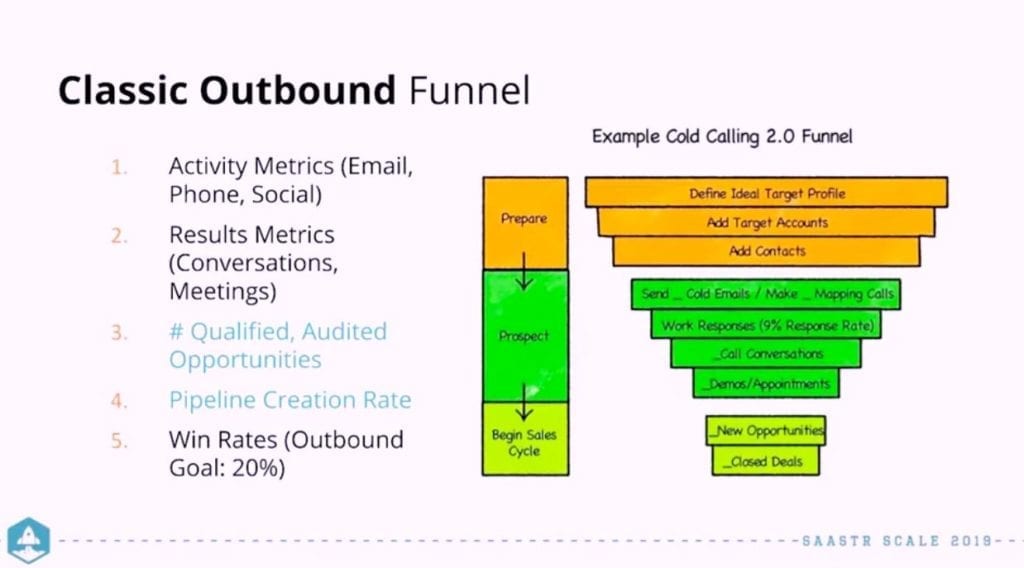 All right, typical dashboard for outbound. Again, your inbound funnel … Sorry, this is an outbound funnel. An inbound funnel will look different than an outbound funnel. So, you have your activities at the top and then those activities are resulting in positive email responses or social responses, meetings. Number three, I think the place where people, again, miss the boat, and it was so, so important, are measuring the number of qualified audited opportunities. What that means is, okay, you’re getting meetings if you have this program. Again, whether it’s your internal team or if it’s some sort of outsourced help, meetings are getting from your SDRs people to salespeople. Okay? But then they’re getting qualified. What does qualified mean to you? It’s a little bit different to everyone else. I’m sorry, everyone has a little bit different versions of what that means. So, first, you need to decide what that means to you. I’ll give you a sample, and then you need to … especially for outbound, you need to audit and review every single opportunity, because I guarantee there’s going to be so much inconsistency. It’s impossible to do it otherwise. That’s what I dealt with from day one at Salesforce.
All right, typical dashboard for outbound. Again, your inbound funnel … Sorry, this is an outbound funnel. An inbound funnel will look different than an outbound funnel. So, you have your activities at the top and then those activities are resulting in positive email responses or social responses, meetings. Number three, I think the place where people, again, miss the boat, and it was so, so important, are measuring the number of qualified audited opportunities. What that means is, okay, you’re getting meetings if you have this program. Again, whether it’s your internal team or if it’s some sort of outsourced help, meetings are getting from your SDRs people to salespeople. Okay? But then they’re getting qualified. What does qualified mean to you? It’s a little bit different to everyone else. I’m sorry, everyone has a little bit different versions of what that means. So, first, you need to decide what that means to you. I’ll give you a sample, and then you need to … especially for outbound, you need to audit and review every single opportunity, because I guarantee there’s going to be so much inconsistency. It’s impossible to do it otherwise. That’s what I dealt with from day one at Salesforce.
So, for outbound qualification, it’s going to be different, typically, than inbound criteria because outbound, you’re reaching out to people who don’t know you as well or don’t know you at all and it may not … They’re not thinking about you and you’re educating them. You’re trying to get them excited about new opportunity. So, usually the three basic criteria for qualifying an outbound opportunity is, am I talking to someone in power or influence? Do they have a need that we can help them with, a real need? And are they interested in the next step? Okay. Some markets, like in advertising, you might talk about budget in a very, kind of … because it’s so ingrained to that system, but usually with outbound, you don’t deal with budget and you don’t deal with timing, but if you’re talking to someone who’s high up enough and has enough of a need, they can make that happen. There’s always exceptions. Let’s not talk about government or schools. So they’ll be looser than inbound criteria. So, again, you take that as your starting point, decide internally what that means, and then someone on the team has to check all those opportunities for consistency.
That’s one way you start to get towards cleaner, most trustworthy metrics on outbound at least, because think about it. If you’re a … There’s a lot of CEOs here. If you’re one or if you work for one, I need to decide, “Hey, we’re getting X from if channels, partners, inbound … ” Of course, inbound is such a group stuff, partners, inbound, outbound. If I don’t trust the metrics, I don’t know what to invest in. Plus, if I don’t trust the metrics, then how does that reflect on the people creating the metrics?
So, I triple emphasize this because at salesforce.com with Mark Bennioff, he didn’t trust outbound metrics because at Oracle, they were all fudged. So his starting point was, “I’m skeptical this is going to work. I don’t think it’s going to add incremental revenue.” It took us two years before he switched, because it was two years of metrics and opportunities and deals, that every time he had a question, I remember there’d be a company … What’s the big trucking company? I don’t know, I’ll just say Citi Bank. Citi Bank, we’d close Citi Bank and he’ll say, “Oh, where’d this come from? A partner’s saying they brought it in, but outbound’s saying they sourced it.” Well, crap. We’d always go back in and be able to prove without a shadow of a doubt that outbound was the source of it. We only took credit for what truly was something we sourced. So, after two years, he finally was like, “Yes, okay, I really believe this is incremental.” Now, that’s an extreme case, but the point is, if you don’t have trustworthy metrics … you don’t want hope, you want truth. Okay, do we beat this horse enough yet?
Sample … okay, so Zuora is one of the new case studies in the Impossible book and this a summary of their outbound funnel. It was interesting about them, which I really … why I wanted to include them in the new edition was because they often take years to close a new customer. That nurturing process for … because they’ll sell to companies like car companies. They have SaS clients too, but they have a lot of older, established businesses that are looking to get into SaaS or a subscription and they might take years to decide to get into that business, so their funnel … again, this is in the book, but 10 new account plans and contacts and dials that they want to filter through to getting about one customer a month. They call them ZBRs, Zuora Business Representatives, doing outbound, mostly outbound.
So, nailing a niche, right? This is number four out of the five points, in terms of how do we reignite growth? This section, this is the stuff that wasn’t in the Predictable Revenue book, that later I realized, “Oh, when people struggle with … let’s go back to outbound,” but it’s true of growth in general. The most common reason is because they haven’t nailed a niche. Now, Twilio, I love their story, right? They have a platform and platforms are really hard to get off the ground because they can be used for anything. You know about the successful ones, but you don’t know about all the unsuccessful ones where they couldn’t get traction to people using it because, well, what do I do with this? It’s like, if Lego had just only sold boxes of pieces and never sold the kit.
So, Twilio has done an amazing job basically getting out of their cubes and ivory towers and learning how to read their customers’ minds. Three of the ways … There’s actually five in the book, but three of the ways here that I thought were really interesting, one is they talk about walking in their customers’ shoes and the repeat it to value. They actually even go to the point of … they offer their customers a free pair of Twilio branded Chucks, which are basically in the picture, but they put their logo on it, if the customer will give them their old, dirty shoes. They hang those old, dirty shoes … maybe they clean them. I don’t know. It doesn’t matter, in the offices as reminders to the employees to, again, walk in your customer’s shoes, because we always need to be reminded of that constantly.
So that’s one, but the second one, make your lawyers build apps. Every employee at Twilio who starts, whether they’re a lawyer or an HR, has to build a Twilio app. They eat their own dog food that way. That was one of the secrets of Salesforce. Salesforce salespeople use Salesforce, so the knew it. How can you get your own people to eat their own dog food? The last one, it’s something we talk about. I think we know this, but how often do we do it? Can we get feedback before we build it? So Twilio, they have an example where it’s an API-based company, so they can do is they can write the documentation first, get feedback from customers before they write the actual APIs. There is a bit of a trick here because it is true, at least from my experience, you can get customer feedback and, at some point though, they don’t really know what they want. You do have to build something, of course, for them to see. If you’re building something new, they’re just … they know the problem, but they don’t know what the solution is but it’s the same old thing, whether it’s for a presentation, whether it’s for a product, try to get customer feedback before you spend a lot of work to build it.
So, getting into the minds of your customers, but here’s a really tactical example. We had a client called Kemberton, who sells multi hundred thousand dollar accounts receivables, financial services to hospitals and they were building an outbound program and they started off by reaching out to hospitals to ask, “Okay, who’s in charge of receivables?” Yes, these emails still work and no, these aren’t the only emails that work that we do, but just a great example. Who’s in charge of receivables? Hospitals are pretty complicated. There’s vendors, there’s patients. We weren’t getting any responses, doing some interviews and such. Interviews, highly underappreciated. They then switched to, “Who handles patient cash?” Right? It was internal language, internal jargon. It was instantly obvious to the people they were reaching out to who that person would be. Right? Speaking their language. You want to be getting to the minds of your customers to use their language.
It’s believable because I see it so often is the kind of emails and cold emails that get sent. They’re so generic and so you-focused, rather than customer-centric. It’s hard, the copywriting skills, it takes practice. As soon as you get it down, things change, but get that practice of getting into their minds, whether that’s through interviews, using the products they’re using, reading the news sources they do, it just makes all the difference. You’re really developing that empathy for them. Empathy is … I’m sure someone has some phrase around, like future skills you have to know or mission-critical skills. Well, empathy is one of them. You’re not going to be able to be successful in marketing without empathy.
All right, we’re going to get to … Here’s the last section. Create revenue team alignment. So revenue team, again, it’s this whole migration from sales and marketing to revenue. How can you look at that? There were sales ops and marketing ops. Now there’s revenue ops. I don’t know, but it’s true. It’s like you don’t really care where it comes from. You want the revenue to work together, but sales versus marketing … revenue team alignment, and there’s reasons why there’s always been this gap between sales and marketing, right? They have different goals. There’s often different backgrounds and experiences. There can be different systems. Maybe they’re in different locations, different budgets, so how do you get them to work together? So here’s three, and I’ll emphasize one, but one of the key steps, it makes such a big difference is having those SDRs, especially on the inbound side, right?
The oldest complaint of marketing in the book is we generate all these leads that don’t get followed up on. True, but you’ve got to realize that salespeople are busy and it’s just, they’re not going to be good at it. They’re just not. That’s just … so if you have an inbound SDR team, then you might call them MRRs, market response reps. It doesn’t matter what you call them, it’s the junior salespeople who are dedicated to responding to inbound leads, whether they’re in website chats, whether they’re … whatever they are. Okay. That’s how you ensure great followup and that’s how you ensure that bridge from marketing leads to sales is solid. Whether they sit under marketing, whether they sit under sales, really the most important thing isn’t the function, it’s which leader will be more passionate and dedicated to making them work well. That’s how you know where they go.
The second one, one revenue leader that speaks both languages, and by the … I know, hey, this kind of stuff actually … there’s probably a bunch of you here that don’t have a sales and marketing leader. You’re just … they’re both you, so I get that. This is a good problem to have, once you actually have a dedicated sales person, a sales leader and marketing leader. Some of you are like, “Oh, I wish I even had that. It’s just me,” but ultimately, you need one leader who speaks both languages and here’s where people go wrong. When there’s a VP of sales and VP of marketing and the CEO, right? The revenue leader is the CEO. They need to work, put more time into … make sure that marketing and sales are synced up. There’s usually too much delegation, like, “Oh, marketing will do their thing and sales can do their thing.” No, they need to be more hands on. It’s more common now to have a CRO or a VP of marketing. We have a VP of revenue.
We have a VP of revenue, Nina, and it was great. We were hoping she could come down here for today, but she’s at burning man. So, what are you going to do? Although I guess nowadays she should be able to dial in, right? But you need that. Who’s that one revenue leader who ultimately will be in charge, not responsible just for the revenue, but also that the two groups are synced. That’s what’s usually missing when you don’t have a CRO or VP of revenue, VPR.
The last one, again, we emphasized in the book is marketing needs some kind of lead commit. So the further along towards revenue, the better. Again, there’s going to be a lot of shades of gray, depending on how advanced or mature you are as a company in your metrics, but typically rather than MQLs or new leads, at least try to get to sales qualified leads, SQLs. There’s so many terms. Okay. SAL, sales accepted leads. Basically it’s the point where the lead gets into the hands of a sales person and they accepted. Whatever you call that, FBI, CIA, TLA, I don’t know. MQL is just not far enough along. If all you can do is measure MQL, great, start there. Just measure SQLs. It is harder because you have to have consistent definitions on what is an SQL. Are people actually logging things in their CRM according to that definition? Right?
So it’s kind of a forcing function to clean up your act as well, to get to the point where you have a trustworthy metric, because that’s where marketing and sales, they agree, right? Sales wants SQLs. Anything earlier than that, it’s kind of … it doesn’t really serve them. So again, it’s a waste of everybody’s time to expect sales to do more followup on earlier leads. It’s just is. You have one out of 10 or one out of 20 or some rare unicorn salesperson that can do everything. They can do the followup, they can do prospects, and they can close, and this, that, and the other, but you can’t build a team out of that.
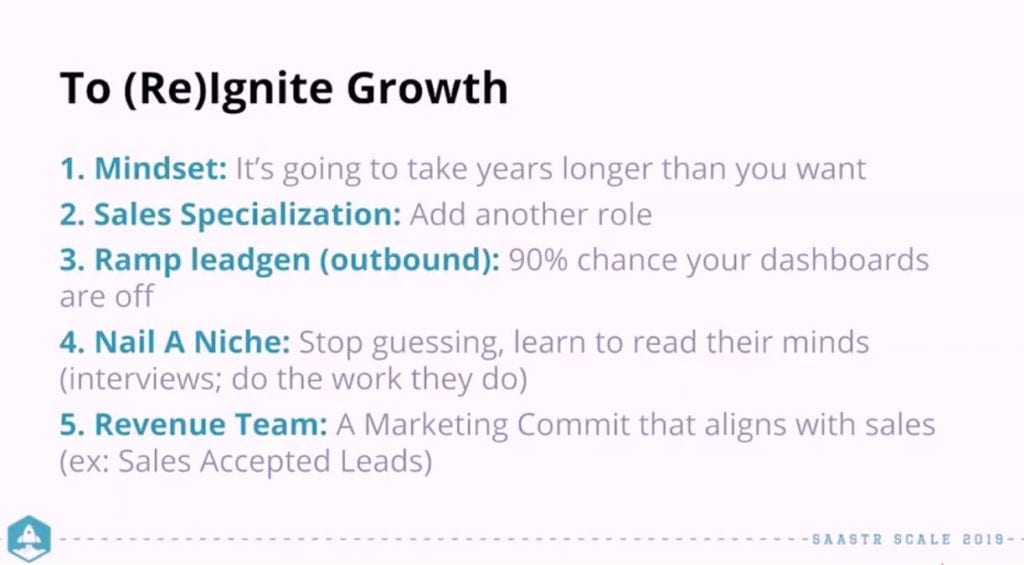 So, to wrap up here, to reignite growth or even if you don’t have it in the first place, get it going. That mindset, how long is it going to take? You don’t know. Have goals, but not expectations, if that makes sense. Any emotional energy wasted, “Oh, I’m not where I need to be yet.” We all feel that to some extent, that’s a waste. Okay, where are you? What’s next? With sales, if you can add more roles, that usually helps. So again, the most common … I thought I saw a report by Bridge Group that 75% of SDR, BDR teams, those STRs do both. They juggle both inbound lead qualification and outbound prospecting. No.
So, to wrap up here, to reignite growth or even if you don’t have it in the first place, get it going. That mindset, how long is it going to take? You don’t know. Have goals, but not expectations, if that makes sense. Any emotional energy wasted, “Oh, I’m not where I need to be yet.” We all feel that to some extent, that’s a waste. Okay, where are you? What’s next? With sales, if you can add more roles, that usually helps. So again, the most common … I thought I saw a report by Bridge Group that 75% of SDR, BDR teams, those STRs do both. They juggle both inbound lead qualification and outbound prospecting. No.
What can you do to ramp lead gen? Whatever works for you. All right. Again, the chances are your dashboards are inaccurate, either they’re not detailed enough in marketing. So the problem with marketing is there’s so many types of campaigns, events and those funnels, and word of mouth. You have to really kind of look at it campaign by campaign, so it’s kind of overwhelming. It’s hard to figure that because it’s so complicated. In outbound, the problem is the subjectivity. You can’t trust the metrics unless you’ve gone down there and there’s someone who’s actually auditing every single opportunity. Then, nailing a niche or niche, I keep … I’m getting in Scotland mode, nailing a niche. So, what can you do to get into the minds of your customers? Usually that’s more interviews. That’s an easy place to start.
The last one, this revenue team. Again, probably the simplest place is looking at, if you have a marketing person or marketing goals, how can you tie them mostly to sales qualified leads, right? But you do have to find that right balance as to where that … for where you are with your stage, what’s going to work. If you had a really fast sales cycle, you could tie marketing totally to … Well, let’s say sales cycle of a few weeks, a month or two, you can probably marketing completely to revenue, but, and if you’re totally new, you don’t, you’re still not sure what your sales stages are on your close rates, you probably have to stick to more like those new leads. So kind of got to find that right balance where you are and then push forward as you can. So, that’s how to reignite growth. Thanks very much. Enjoy your day here. I’m going to be around for about an hour before I try to get back to Los Angeles where we’re currently living. So, thanks very much. Really a pleasure to be up here and thanks to the SaaStr team. Great job.

